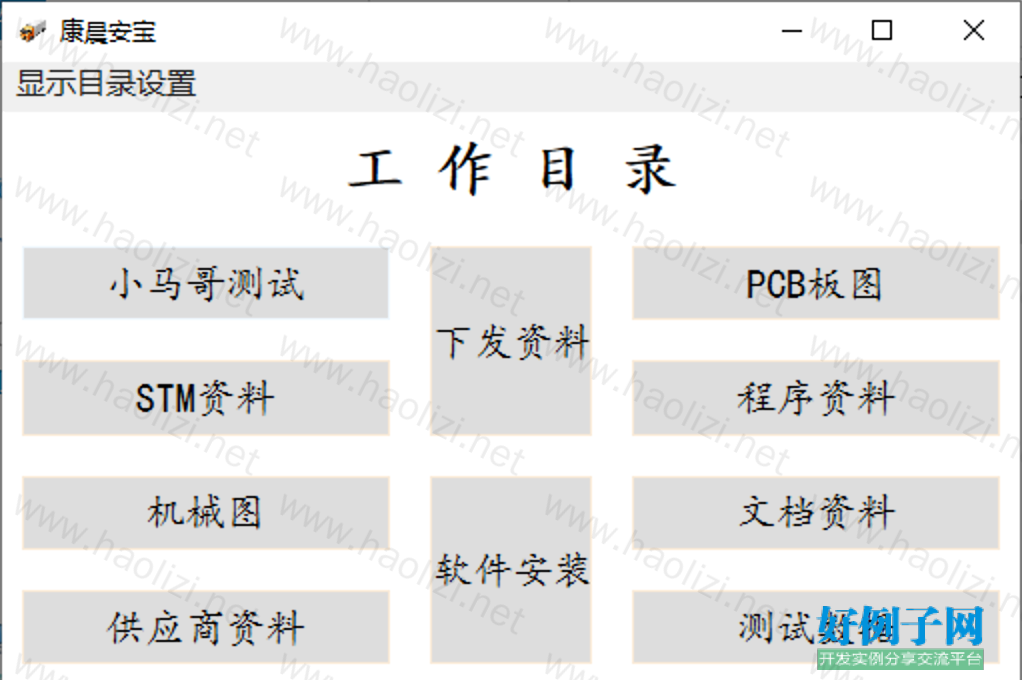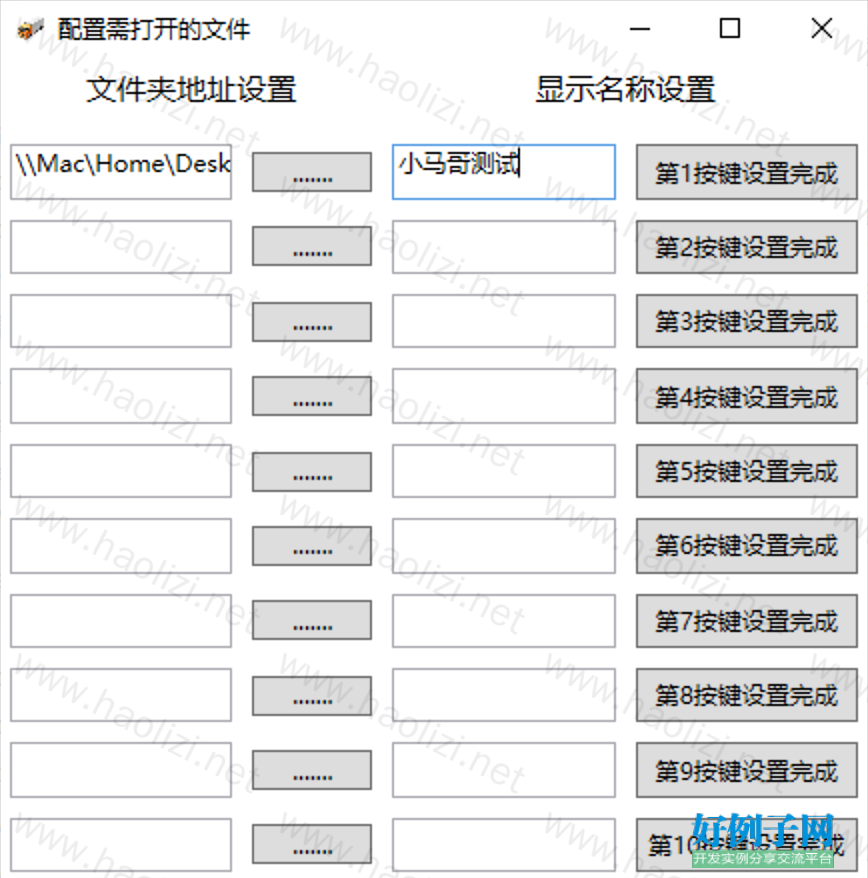实例介绍
【实例简介】
【实例截图】


【核心代码】
using Microsoft.Win32;
using System;
using System.Collections.Generic;
using System.IO;
using System.Linq;
using System.Text;
using System.Threading.Tasks;
using System.Windows;
using System.Windows.Controls;
using System.Windows.Data;
using System.Windows.Documents;
using System.Windows.Input;
using System.Windows.Media;
using System.Windows.Media.Imaging;
using System.Windows.Navigation;
using System.Windows.Shapes;
using System.Configuration;
using System.Diagnostics;
using System.Windows.Interop;
namespace 桌面操作工具
{
/// <summary>
/// MainWindow.xaml 的交互逻辑
/// </summary>
///
///
public partial class MainWindow : Window
{
Configuration cfa = ConfigurationManager.OpenExeConfiguration(ConfigurationUserLevel.None);
public MainWindow()
{
InitializeComponent();
}
//private void BTN_Click(object sender, RoutedEventArgs e)
//{
// // OpenFileDialog fileDialog = new OpenFileDialog();
// // fileDialog.Multiselect = true;
// // fileDialog.OpenFile (TXB.Text.ToString());
// //fileDialog.Title = TXB.Text.ToString();
// // fileDialog.Filter = "所有文件(*.*)|*.*";
// // if (DialogResult.HasValue)
// // {
// // fileDialog.ShowDialog();
// // }
// // else
// // {
// // MessageBox.Show("无指定文件");
// // }
// //打开文件System.Diagnostics.Process.Start(v_OpenFilePath);
// //打开指定目录的文件夹string v_OpenFolderPath = @"目录路径";
// //System.Diagnostics.Process.Start("explorer.exe", v_OpenFolderPath);
//// string v_OpenFolderPath =@"E:\6.4资料";
//// System.Diagnostics.Process.Start("explorer.exe", v_OpenFolderPath);
//}
string No1_adress, No2_adress, No3_adress, No4_adress, No5_adress, No6_adress, No7_adress, No8_adress, No9_adress, No10_adress;
//[System.Runtime.InteropServices.DllImport("User32.dll")]
//private static extern bool ShowWindowAsync(IntPtr hWnd, int cmdShow);
//[System.Runtime.InteropServices.DllImport("user32.dll")]
//private static extern int SetForegroundWindow(IntPtr hWnd);
private void Window_Load(object sender, RoutedEventArgs e)
{
Process[] pro = Process.GetProcesses();
int n = pro.Where(p => p.ProcessName.Equals("桌面操作工具")).Count();
if (n > 1)
{
//ShowWindowAsync(new System.Windows.Interop.WindowInteropHelper(CommonHelper.view).Handle, 1);
//SetForegroundWindow(new System.Windows.Interop.WindowInteropHelper(CommonHelper.view).Handle);
MessageBox.Show("该程序重复开启");
Application.Current.Shutdown();
return;
}
Readconfig();
// OpenFileDialog openFileDialog1 = new OpenFileDialog();
// openFileDialog1.Filter = "文本文件(*.txt)|*.txt|(*.rtf)|*.rtf";
//if ((bool)openFileDialog1.ShowDialog())
// { }
}
public void Readconfig()
{
BTN_1.Content = ConfigurationManager.AppSettings["Name1"];
BTN_2.Content = ConfigurationManager.AppSettings["Name2"];
BTN_3.Content = ConfigurationManager.AppSettings["Name3"];
BTN_4.Content = ConfigurationManager.AppSettings["Name4"];
BTN_5.Content = ConfigurationManager.AppSettings["Name5"];
BTN_6.Content = ConfigurationManager.AppSettings["Name6"];
BTN_7.Content = ConfigurationManager.AppSettings["Name7"];
BTN_8.Content = ConfigurationManager.AppSettings["Name8"];
BTN_9.Content = ConfigurationManager.AppSettings["Name9"];
BTN_10.Content = ConfigurationManager.AppSettings["Name10"];
No1_adress = ConfigurationManager.AppSettings["Path1"];
No2_adress = ConfigurationManager.AppSettings["Path2"];
No3_adress = ConfigurationManager.AppSettings["Path3"];
No4_adress = ConfigurationManager.AppSettings["Path4"];
No5_adress = ConfigurationManager.AppSettings["Path5"];
No6_adress = ConfigurationManager.AppSettings["Path6"];
No7_adress = ConfigurationManager.AppSettings["Path7"];
No8_adress = ConfigurationManager.AppSettings["Path8"];
No9_adress = ConfigurationManager.AppSettings["Path9"];
No10_adress = ConfigurationManager.AppSettings["Path10"];
}
private void BTN_1_Click(object sender, RoutedEventArgs e)
{
string v_OpenFolderPath = @No1_adress;
System.Diagnostics.Process.Start("explorer.exe", v_OpenFolderPath);
}
private void BTN_2_Click(object sender, RoutedEventArgs e)
{
string v_OpenFolderPath = @No2_adress;
System.Diagnostics.Process.Start("explorer.exe", v_OpenFolderPath);
}
private void BTN_3_Click(object sender, RoutedEventArgs e)
{
string v_OpenFolderPath = @No3_adress;
System.Diagnostics.Process.Start("explorer.exe", v_OpenFolderPath);
}
private void BTN_4_Click(object sender, RoutedEventArgs e)
{
string v_OpenFolderPath = @No4_adress;
System.Diagnostics.Process.Start("explorer.exe", v_OpenFolderPath);
}
private void BTN_5_Click(object sender, RoutedEventArgs e)
{
string v_OpenFolderPath = @No5_adress;
System.Diagnostics.Process.Start("explorer.exe", v_OpenFolderPath);
}
private void BTN_6_Click(object sender, RoutedEventArgs e)
{
string v_OpenFolderPath = @No6_adress;
System.Diagnostics.Process.Start("explorer.exe", v_OpenFolderPath);
}
private void BTN_7_Click(object sender, RoutedEventArgs e)
{
string v_OpenFolderPath = @No7_adress;
System.Diagnostics.Process.Start("explorer.exe", v_OpenFolderPath);
}
private void BTN_8_Click(object sender, RoutedEventArgs e)
{
string v_OpenFolderPath = @No8_adress;
System.Diagnostics.Process.Start("explorer.exe", v_OpenFolderPath);
}
private void BTN_9_Click(object sender, RoutedEventArgs e)
{
string v_OpenFolderPath = @No9_adress;
System.Diagnostics.Process.Start("explorer.exe", v_OpenFolderPath);
}
private void BTN_10_Click(object sender, RoutedEventArgs e)
{
string v_OpenFolderPath = @No10_adress;
System.Diagnostics.Process.Start("explorer.exe", v_OpenFolderPath);
}
private void Set_Click(object sender, RoutedEventArgs e)
{
Set set = new Set();
set.Show();
this.Close();
}
}
}
好例子网口号:伸出你的我的手 — 分享!
小贴士
感谢您为本站写下的评论,您的评论对其它用户来说具有重要的参考价值,所以请认真填写。
- 类似“顶”、“沙发”之类没有营养的文字,对勤劳贡献的楼主来说是令人沮丧的反馈信息。
- 相信您也不想看到一排文字/表情墙,所以请不要反馈意义不大的重复字符,也请尽量不要纯表情的回复。
- 提问之前请再仔细看一遍楼主的说明,或许是您遗漏了。
- 请勿到处挖坑绊人、招贴广告。既占空间让人厌烦,又没人会搭理,于人于己都无利。
关于好例子网
本站旨在为广大IT学习爱好者提供一个非营利性互相学习交流分享平台。本站所有资源都可以被免费获取学习研究。本站资源来自网友分享,对搜索内容的合法性不具有预见性、识别性、控制性,仅供学习研究,请务必在下载后24小时内给予删除,不得用于其他任何用途,否则后果自负。基于互联网的特殊性,平台无法对用户传输的作品、信息、内容的权属或合法性、安全性、合规性、真实性、科学性、完整权、有效性等进行实质审查;无论平台是否已进行审查,用户均应自行承担因其传输的作品、信息、内容而可能或已经产生的侵权或权属纠纷等法律责任。本站所有资源不代表本站的观点或立场,基于网友分享,根据中国法律《信息网络传播权保护条例》第二十二与二十三条之规定,若资源存在侵权或相关问题请联系本站客服人员,点此联系我们。关于更多版权及免责申明参见 版权及免责申明



网友评论
我要评论